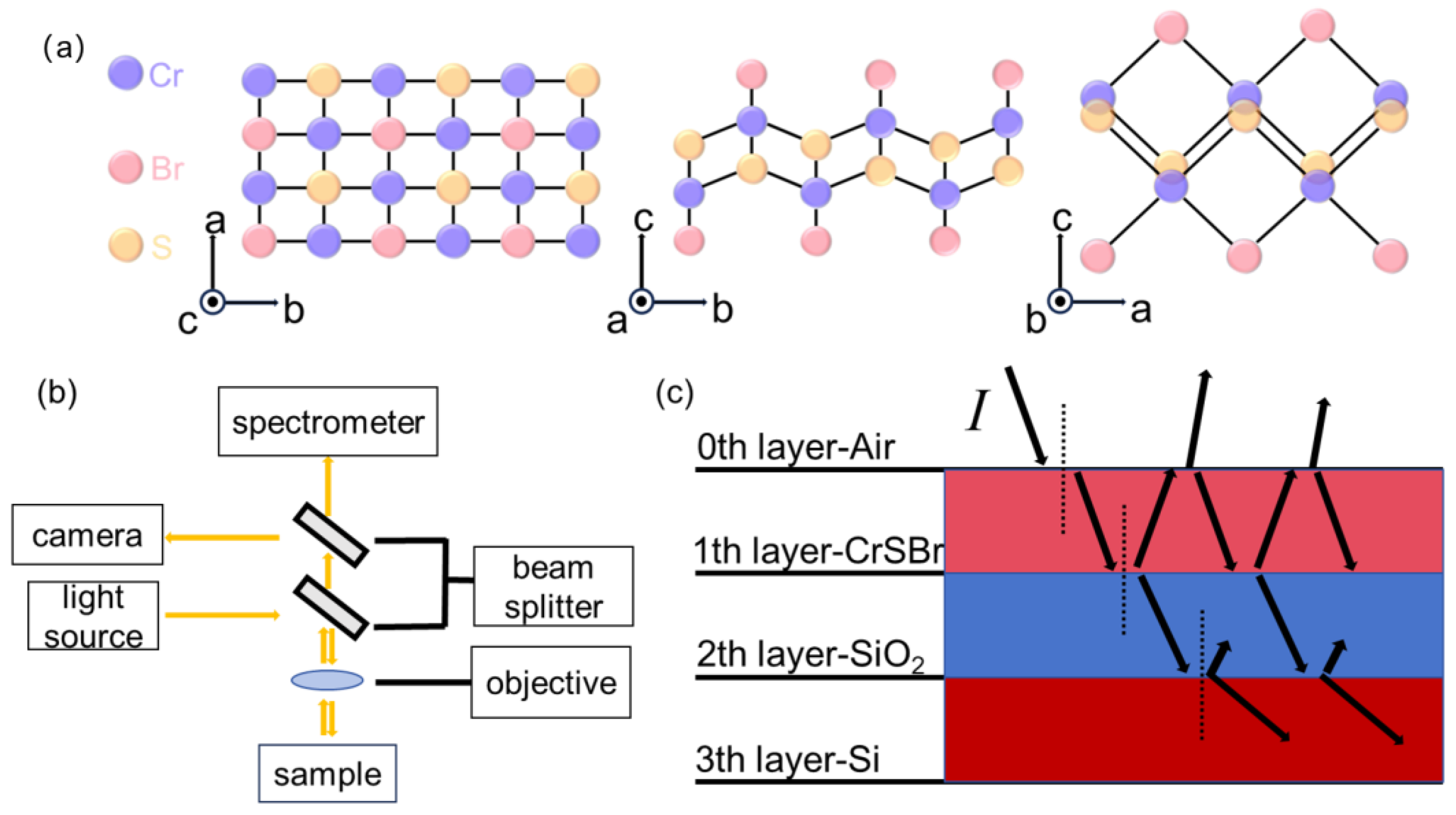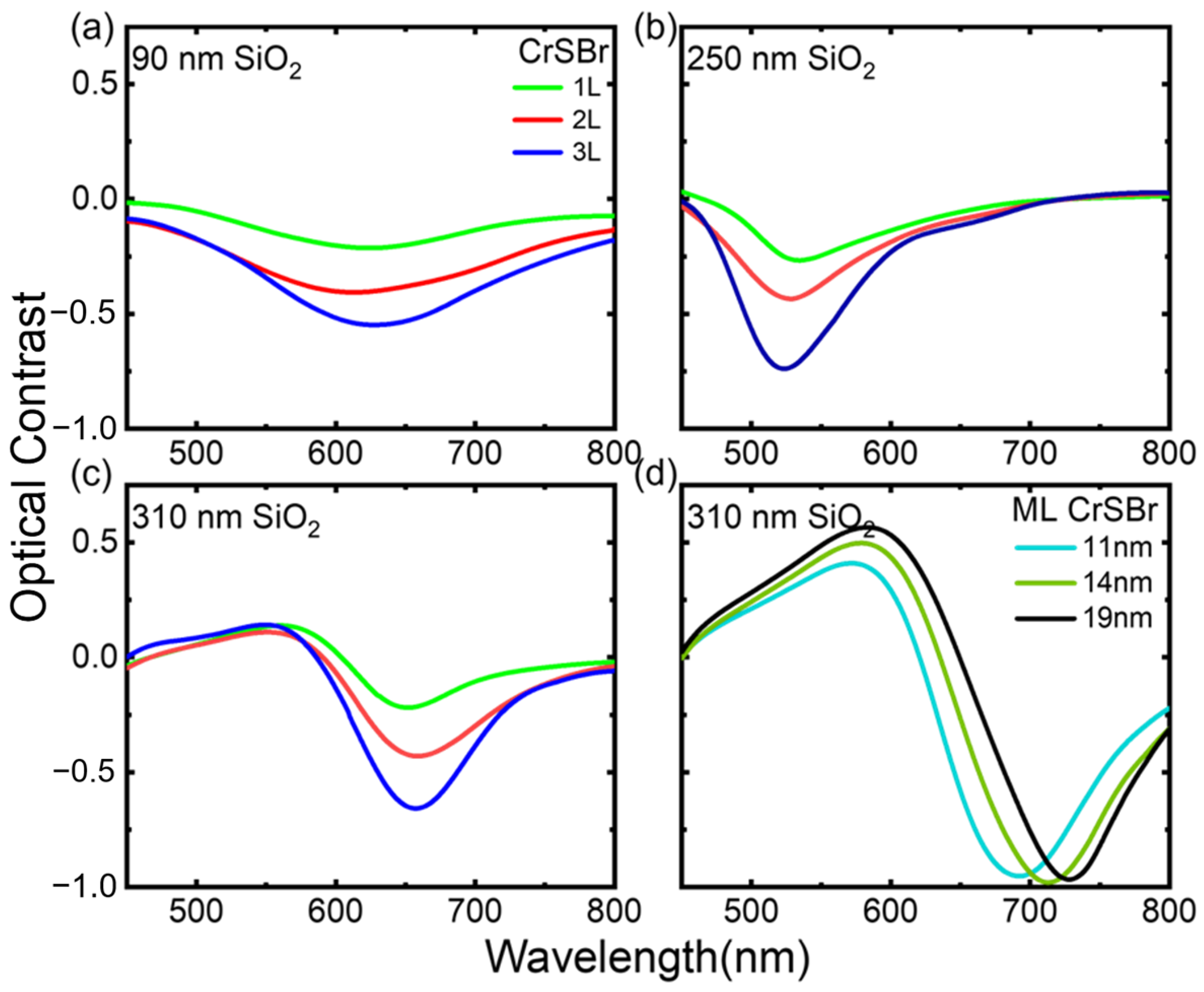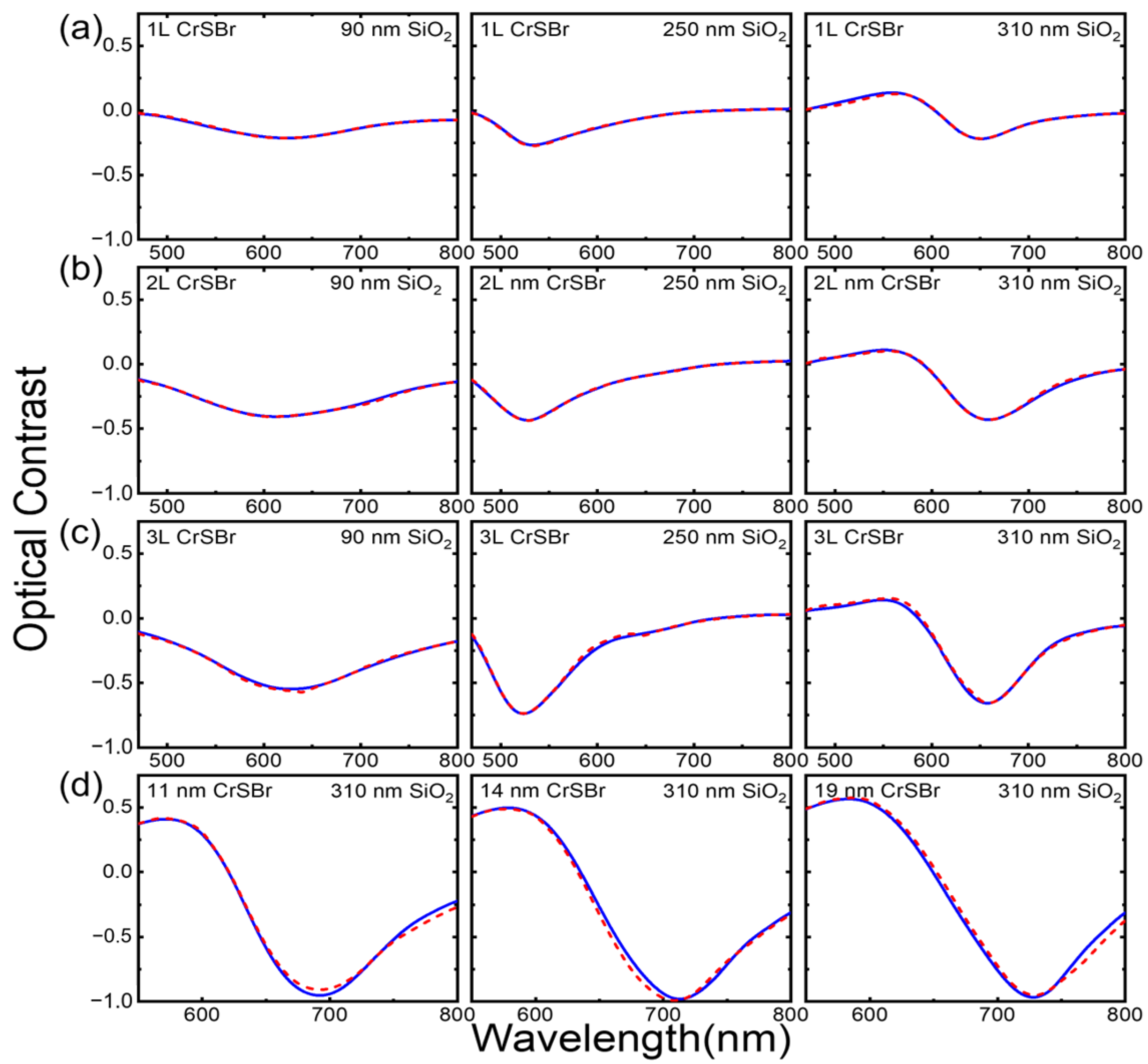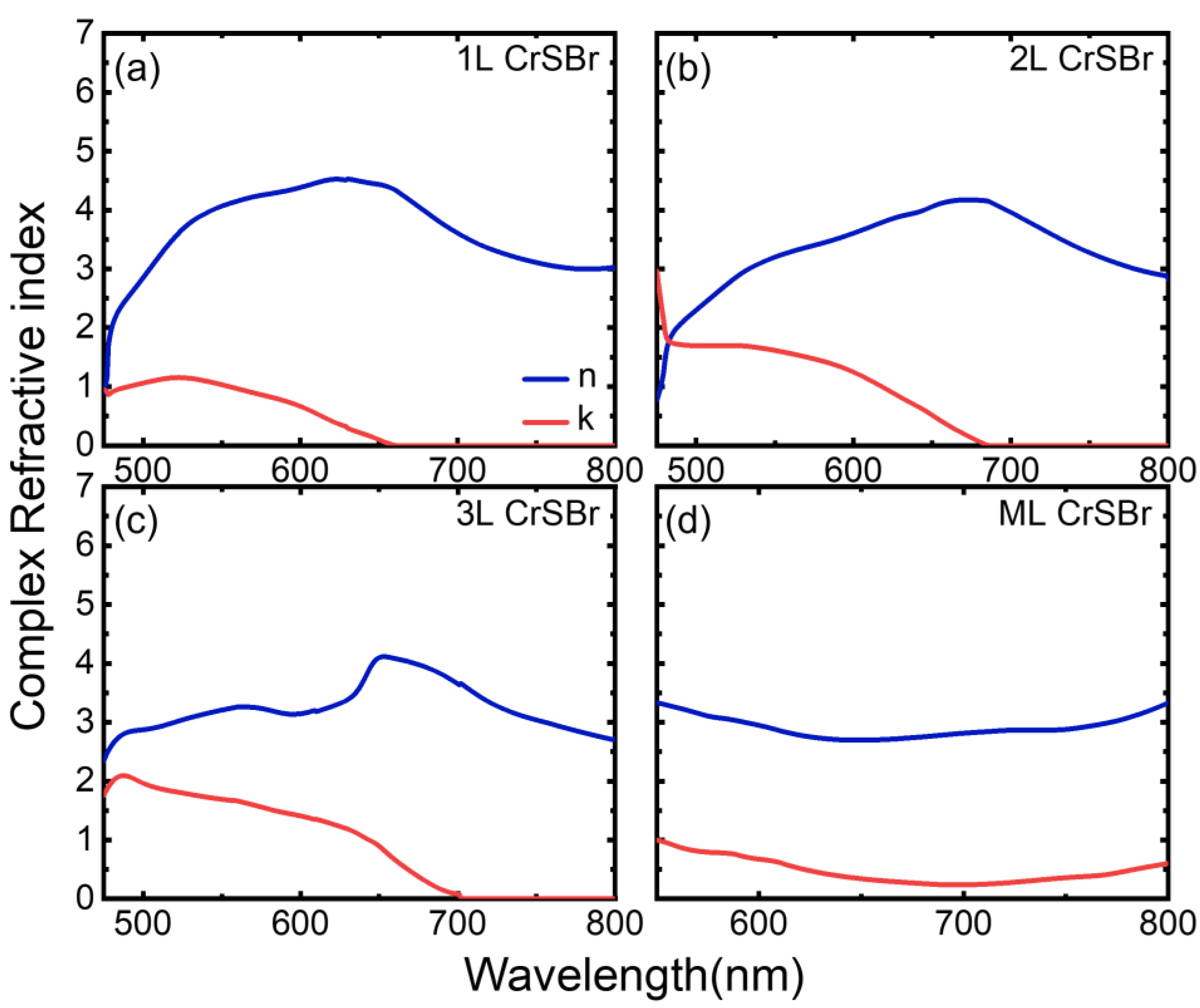Layer Dependence of Complex Refractive Index in CrSBr
Abstract
1. Introduction
2. Materials and Methods
2.1. Sample Preparation
2.2. Optical Contrast Measurement
2.3. Extraction of the Refractive Index
3. Results and Discussion
4. Conclusions
Author Contributions
Funding
Institutional Review Board Statement
Informed Consent Statement
Data Availability Statement
Conflicts of Interest
References
- Liu, Y.; Zeng, C.; Zhong, J.; Ding, J.; Wang, Z.M.; Liu, Z. Spintronics in Two-Dimensional Materials. Nano-Micro Lett. 2020, 12, 93. [Google Scholar] [CrossRef] [PubMed]
- Bazarnik, M.; Lo Conte, R.; Mascot, E.; Bergmann, K.v.; Morr, D.K.; Wiesendanger, R. Antiferromagnetism-driven two-dimensional topological nodal-point superconductivity. Nat. Commun. 2023, 14, 614. [Google Scholar] [CrossRef] [PubMed]
- Gu, P.; Wang, C.; Su, D.; Dong, Z.; Wang, Q.; Han, Z.; Watanabe, K.; Taniguchi, T.; Ji, W.; Sun, Y.; et al. Multi-state data storage in a two-dimensional stripy antiferromagnet implemented by magnetoelectric effect. Nat. Commun. 2023, 14, 3221. [Google Scholar] [CrossRef] [PubMed]
- Ye, C.; Wang, C.; Wu, Q.; Liu, S.; Zhou, J.; Wang, G.; Söll, A.; Sofer, Z.; Yue, M.; Liu, X.; et al. Layer-Dependent Interlayer Antiferromagnetic Spin Reorientation in Air-Stable Semiconductor CrSBr. ACS Nano 2022, 16, 11876–11883. [Google Scholar] [CrossRef]
- Lee, K.; Dismukes, A.H.; Telford, E.J.; Wiscons, R.A.; Wang, J.; Xu, X.; Nuckolls, C.; Dean, C.R.; Roy, X.; Zhu, X. Magnetic Order and Symmetry in the 2D Semiconductor CrSBr. Nano Lett. 2021, 21, 3511–3517. [Google Scholar] [CrossRef] [PubMed]
- Diederich, G.M.; Cenker, J.; Ren, Y.; Fonseca, J.; Chica, D.G.; Bae, Y.J.; Zhu, X.; Roy, X.; Cao, T.; Xiao, D.; et al. Tunable interaction between excitons and hybridized magnons in a layered semiconductor. Nat. Nanotechnol. 2023, 18, 23–28. [Google Scholar] [CrossRef]
- Telford, E.J.; Dismukes, A.H.; Lee, K.; Cheng, M.; Wieteska, A.; Bartholomew, A.K.; Chen, Y.; Xu, X.; Pasupathy, A.N.; Zhu, X.; et al. Layered Antiferromagnetism Induces Large Negative Magnetoresistance in the van der Waals Semiconductor CrSBr. Adv. Mater. 2022, 32, 2003240. [Google Scholar] [CrossRef] [PubMed]
- Yang, K.; Wang, G.; Liu, L.; Lu, D.; Wu, H. Triaxial magnetic anisotropy in the two-dimensional ferromagnetic semiconductor CrSBr. Phys. Rev. B 2021, 104, 144416. [Google Scholar] [CrossRef]
- Tang, C.; Zhang, Z.; Lai, S.; Tan, Q.; Gao, W. Magnetic Proximity Effect in Graphene/CrBr3 van der Waals Heterostructures. Adv. Mater. 2020, 32, 1908498. [Google Scholar] [CrossRef]
- Ziebel, M.E.; Feuer, M.L.; Cox, J.; Zhu, X.; Dean, C.R.; Roy, X. CrSBr: An Air-Stable, Two-Dimensional Magnetic Semiconductor. Nano Lett. 2024, 24, 4319–4329. [Google Scholar] [CrossRef]
- Marques-Moros, F.; Boix-Constant, C.; Manas-Valero, S.; Canet-Ferrer, J.; Coronado, E. Interplay between Optical Emission and Magnetism in the van der Waals Magnetic Semiconductor CrSBr in the Two-Dimensional Limit. ACS Nano 2023, 17, 13224–13231. [Google Scholar] [CrossRef]
- Pawbake, A.; Pelini, T.; Mohelsky, I.; Jana, D.; Breslavetz, I.; Cho, C.; Orlita, M.; Potemski, M.; Measson, M.; Wilson, N.P.; et al. Magneto-Optical Sensing of the Pressure Driven Magnetic Ground States in Bulk CrSBr. Nano Lett. 2023, 23, 9587–9593. [Google Scholar] [CrossRef]
- Linhart, W.M.; Rybak, M.; Birowska, M.; Scharoch, P.; Mosina, K.; Mazanek, V.; Kaczorowski, D.; Sofer, Z.; Kudrawiec, R. Optical markers of magnetic phase transition in CrSBr. J. Mater. Chem. C 2023, 11, 8423–8430. [Google Scholar] [CrossRef]
- Golovynskyi, S.; Irfan, I.; Bosi, M.; Seravalli, L.; Datsenko, O.I.; Golovynska, I.; Li, B.; Lin, D.; Qu, J. Exciton and trion in few-layer MoS2: Thickness- and temperature-dependent photoluminescence. Appl. Surf. Sci. 2020, 515, 146033. [Google Scholar] [CrossRef]
- Gonzalez, J.M.; Oleynik, I.I. Layer-dependent properties of SnS2 and SnSe2 two-dimensional materials. Phys. Rev. B 2016, 94, 125443. [Google Scholar] [CrossRef]
- Shiogai, J.; Kimura, S.; Awaji, S.; Nojima, T.; Tsukazaki, A. Anisotropy of the upper critical field and its thickness dependence in superconducting FeSe electric-double-layer transistors. Phys. Rev. B 2018, 97, 174520. [Google Scholar] [CrossRef]
- Klein, J.; Pingault, B.; Florian, M.; Heißenbüttel, M.-C.; Steinhoff, A.; Song, Z.; Torres, K.; Dirnberger, F.; Curtis, J.B.; Weile, M. The Bulk van der Waals Layered Magnet CrSBr is a Quasi-1D Material. ACS Nano 2023, 17, 5316–5328. [Google Scholar] [CrossRef] [PubMed]
- Li, Y.; Chernikov, A.; Zhang, X.; Rigosi, A.; Hill, H.M.; Zande, A.M.; Chenet, D.A.; Shih, E.; Hone, J.; Heinz, T. Measurement of the optical dielectric function of monolayer transition-metal dichalcogenides:MoS2, MoSe2, WS2, and WSe2. Phys. Rev. B 2014, 90, 205422. [Google Scholar] [CrossRef]
- McCrackin, F.L.; Passaglia, E.; Stromberg, R.R.; Steinberg, H.L. Measurement of the Thickness and Refractive Index of Very Thin Films and the Optical Properties of Surfaces by Ellipsometry. J. Res. Natl. Bur. Stand. Sect. A Phys. Chem. 1963, 67A, 363–377. [Google Scholar] [CrossRef] [PubMed]
- Papadopoulos, N.; Frisenda, R.; Biele, R.; Flores, E.; Ares, J.R.; Sanchez, C.; Zant, H.S.J.; Ferrer, I.J.; D’Agosta, R.; Castellanos-Gomez, A. Large birefringence and linear dichroism in TiS3 nanosheets. Nanoscale 2018, 10, 12424–12429. [Google Scholar] [CrossRef]
- Gant, P.; Ghasemi, F.; Maeso, D.; Munuera, C.; López-Elvira, E.; Frisenda, R.; De Lara, D.P.; Rubio-Bollinger, G.; Garcia-Hernandez, M.; Castellanos-Gomez, A. Optical contrast and refractive index of natural van der Waals heterostructure nanosheets of franckeite. Beilstein J. Nanotechnol. 2017, 8, 2357–2362. [Google Scholar] [CrossRef] [PubMed]
- Castellanos-Gomez, A.; Agraït, N.; Rubio-Bollinger, G. Optical identification of atomically thin dichalcogenide crystals. Appl. Phys. Lett. 2010, 96, 213116. [Google Scholar] [CrossRef]
- Li, H.; Wu, J.; Huang, X.; Lu, G.; Yang, J.; Lu, X.; Xiong, Q.; Zhang, H. Rapid and Reliable Thickness Identification of Two-Dimensional Nanosheets Using Optical Microscopy. ACS Nano 2013, 7, 10344–10353. [Google Scholar] [CrossRef] [PubMed]
- Telford, E.; Dismukes, A.; Dudley, R.L.; Wiscons, R.A.; Lee, K.; Yu, J.; Shabani, S.; Scheie, A.; Watanabe, K.; Taniguchi, T.; et al. Hidden low-temperature magnetic order revealed through magnetotransport in monolayer CrSBr. arXiv 2021, arXiv:2106.08471. [Google Scholar]
- Frisenda, R.; Niu, Y.; Gant, P.; Molina-Mendoza, A.J.; Schmidt, R.; Bratschitsch, R.; Liu, J.; Fu, L.; Dumcenco, D.; Kis, A. Micro-reflectance and transmittance spectroscopy: A versatile and powerful tool to characterize 2D materials. J. Phys. D: Appl. Phys. 2017, 50, 074002. [Google Scholar] [CrossRef]
- Hsu, C.; Frisenda, R.; Schmidt, R.; Arora, A.; de Vasconcellos, S.M.; Bratschitsch, R.; van der Zant, H.S.J.; Castellanos-Gomez, A. Thickness-Dependent Refractive Index of 1L, 2L, and 3L MoS2, MoSe2, WS2, and WSe2. Adv. Funct. Mater. 2019, 7, 1900239. [Google Scholar] [CrossRef]
- Torres, K.; Kuc, A.; Maschio, L.; Pham, T.; Reidy, K.; Dekanovsky, L.; Sofer, Z.; Ross, F.M.; Klein, J. Probing Defects and Spin-Phonon Coupling in CrSBr via Resonant Raman Scattering. Adv. Funct. Mater. 2023, 33, 2211366. [Google Scholar] [CrossRef]
- MacLeod, H.A. Thin-Film Optical Filters; CRC Press: Boca Raton, FL, USA, 2010; ISBN 9780429136511. [Google Scholar]
- Hecht, E. Optics, 4th ed.; Addison-Wesley: San Francisco, CA, USA, 2001; ISBN 9780805385663. [Google Scholar]
- Krečmarová, M.; Andres-Penares, D.; Fekete, L.; Ashcheulov, P.; Molina-Sánchez, A.; Canet-Albiach, R.; Gregora, I.; Mortet, V.; Martínez-Pastor, J.P.; Sánchez-Royo, J.F. Optical Contrast and Raman Spectroscopy Techniques Applied to Few-Layer 2D Hexagonal Boron Nitride. Nanomaterials 2019, 9, 1047. [Google Scholar] [CrossRef]
- Bing, D.; Wang, Y.; Bai, J.; Du, R.; Wu, G.; Liu, L. Optical contrast for identifying the thickness of two-dimensional materials. Opt. Commun. 2018, 406, 128–138. [Google Scholar] [CrossRef]
- Ciddor, P.E. Refractive index of air: New equations for the visible and near infrared. Appl. Opt. 1996, 35, 1566–1573. [Google Scholar] [CrossRef]
- Arosa, Y.; de la Fuente, R. Refractive index spectroscopy and material dispersion in fused silica glass. Opt Lett. 2020, 45, 4268–4271. [Google Scholar] [CrossRef] [PubMed]
- Schinke, C.; Christian, P.; Schmidt, J.; Brendel, R.; Bothe, K.; Vogt, M.R.; Kröger, I.; Winter, S.; Schirmacher, A.; Lim, S.; et al. Uncertainty analysis for the coefficient of band-to-band absorption of crystalline silicon. AIP Adv. 2015, 5, 067168. [Google Scholar] [CrossRef]
- Qiu, B.; Zhao, X.; Hu, G.; Yue, W.; Ren, J.; Yuan, X. Optical Properties of Graphene/MoS2 Heterostructure: First Principles Calculations. Nanomaterials 2018, 8, 962. [Google Scholar] [CrossRef] [PubMed]
- Zhao, Q.; Puebla, S.; Zhang, W.; Wang, T.; Frisenda, R.; Castellanos-Gomez, A. Thickness Identification of Thin InSe byOptical Microscopy Methods. Adv. Photonics Res. 2020, 1, 2000025. [Google Scholar] [CrossRef]
- Canet-Ferrer, J.; Munoz-Matutano, G.; Fuster, D.; Alen, B.; Gonzalez, Y.; Gonzalez, L.; Martinez-Pastor, J.P. Localization Effectson Recombination Dynamics in InAs/InP Self-Assembled QuantumWires Emitting at 1.5 um. J. Appl. Phys. 2011, 110, 1. [Google Scholar] [CrossRef]
- Sánchez-Royo, J.F.; Muñáoz-Matutano, G.; Brotons-Gisbert, M.; Martínez-Pastor, J.P.; Segura, A.; Cantarero, A.; Mata, R.; Canet-Ferrer, J.; Tobias, G.; Canadell, E.; et al. Electronic Structure, Optical Properties, and Lattice Dynamics inAtomically Thin Indium Selenide Flakes. Nano Res. 2014, 7, 1556–1568. [Google Scholar] [CrossRef]
- Wang, K.; Paulus, B. Tuning the binding energy of excitons in the MoS2 monolayer by molecular functionalization and defective engineering. Phys. Chem. Chem. Phys. 2020, 22, 11936–11942. [Google Scholar] [CrossRef]
- Zhu, B.; Chen, X.; Cui, X. Exciton Binding Energy of Monolayer WS2. Sci. Rep. 2015, 5, 9218. [Google Scholar] [CrossRef]
- Ugeda, M.M.; Bradley, A.J.; Shi, S.; da Jornada, F.H.; Zhang, Y.; Qiu, D.Y.; Ruan, W.; Mo, S.; Hussain, Z.; Shen, Z.; et al. Giant bandgap renormalization and excitonic effects in a monolayer transition metal dichalcogenide semiconductor. Nat. Mater. 2014, 13, 1091–1095. [Google Scholar] [CrossRef]
- He, K.; Kumar, N.; Zhao, L.; Wang, Z.; Mak, K.F.; Zhao, H.; Shan, J. Tightly Bound Excitons in Monolayer WSe2. Phys. Rev. Lett. 2014, 113, 026803. [Google Scholar] [CrossRef]





Disclaimer/Publisher’s Note: The statements, opinions and data contained in all publications are solely those of the individual author(s) and contributor(s) and not of MDPI and/or the editor(s). MDPI and/or the editor(s) disclaim responsibility for any injury to people or property resulting from any ideas, methods, instructions or products referred to in the content. |
© 2024 by the authors. Licensee MDPI, Basel, Switzerland. This article is an open access article distributed under the terms and conditions of the Creative Commons Attribution (CC BY) license (https://creativecommons.org/licenses/by/4.0/).
Share and Cite
Hu, C.; Cheng, H.; Zhou, J.; Zhang, K.; Liu, X.; Jiang, Y. Layer Dependence of Complex Refractive Index in CrSBr. Materials 2024, 17, 3430. https://doi.org/10.3390/ma17143430
Hu C, Cheng H, Zhou J, Zhang K, Liu X, Jiang Y. Layer Dependence of Complex Refractive Index in CrSBr. Materials. 2024; 17(14):3430. https://doi.org/10.3390/ma17143430
Chicago/Turabian StyleHu, Chao, Huanghuang Cheng, Jiayuan Zhou, Kai Zhang, Xue Liu, and Yuxuan Jiang. 2024. "Layer Dependence of Complex Refractive Index in CrSBr" Materials 17, no. 14: 3430. https://doi.org/10.3390/ma17143430
APA StyleHu, C., Cheng, H., Zhou, J., Zhang, K., Liu, X., & Jiang, Y. (2024). Layer Dependence of Complex Refractive Index in CrSBr. Materials, 17(14), 3430. https://doi.org/10.3390/ma17143430





